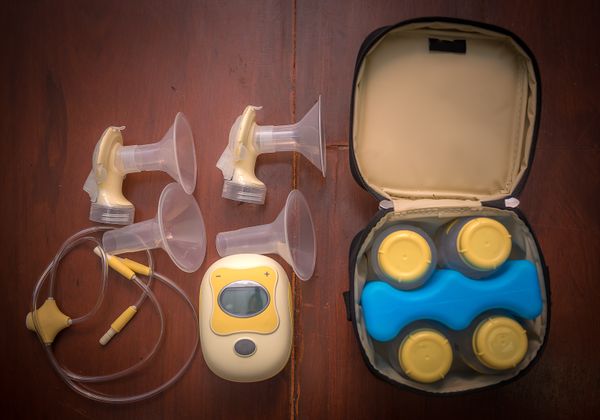Not all new moms and babies get the hang of breastfeeding right away. For many, it's challenging at first. You make a few mistakes or have some breastfeeding problems along the way. Before you know it, though, you and your baby can be on the path to a smooth and successful breastfeeding relationship.
Here are some common breastfeeding problems and how to solve them. Once you resolve your difficulties, breastfeeding will be more enjoyable for both you and your baby.
Problem one: Low milk supply
Solution: Sometimes the problem isn't really low milk supply but just the concern that you may not be supplying enough milk. Try weighing your baby before and after a feeding. If your baby is gaining weight (and pooping too), you're likely producing enough milk. And remember, the more you nurse and pump, the more you'll increase your milk supply. You can also try renting a hospital-grade pump (find rental spots online). They help produce milk quickly and are used in hospitals by preemie moms and under other special circumstances.
Problem two: Cracked nipples
Solution: Cracked nipples are often caused by latching and positioning problems. As much of the areola as possible, including the bottom part beneath your nipple, should be in your baby's mouth. His sucking will be softer if he isn't so hungry at feeding time, so try feeding him more often. To ease the pain, express a little milk onto the nipple and let it air dry at the end of the feeding. In addition to positioning, improper use of a breast pump and thrush (see below) can cause cracked nipples. Talk to your health care provider or lactation consultant to find the source of the problem. Nipples generally heal quickly after the cause of the problem is identified and remedied. Try cleaning your nipples with water. Avoid soaps, lotions and perfumes, which will only worsen the situation. You can also use lanolin-based cream or antibiotic ointment on cracked nipples, but check with your health care provider to make sure you use the best product for your problem. If needed, take acetaminophen, ibuprofen or another mild painkiller 30 minutes before you nurse.
Problem three: Engorgement
Solution: Do your breasts feel swollen, hard, painful and uncomfortably full? You likely have engorgement. When you're engorged, it can be difficult for your baby to latch on correctly because your breast is hard and can't conform to the baby's mouth. Try expressing milk manually or with an electric breast pump until your breasts soften. That will help promote milk flow and make it easier for your baby to get milk and latch on. The more you nurse, the less likely your breasts are to get engorged.
Problem four: Latching pain
Solution: If your baby has latched on and you're in pain for more than a minute into feeding, your baby may be in the wrong position. Before breaking the suction, try to gently adjust your baby's position by bringing her closer or by slightly shifting her position. If that can be done, it eliminates the frustration of the infant having to latch on again. If that doesn't work, reposition your baby by waiting for her to yawn, tickling her chin or putting your pinky into the side of her sucking mouth to break the suction. Then reposition her, making sure she has as much of the areola in her mouth as possible. You want her chin and nose touching your breast and you shouldn't be seeing part of your lower areola or nipple. Your lactation consultant can help you find the proper position.
Problem five: Clogged, plugged or blocked ducts
Solution: A plugged duct may feel red, tender or hot in one area of the breast. You may also see a small, hard lump or a white dot on the nipple duct. It's happening because your milk isn't completely draining. To help prevent this issue, see if your nursing bra is too tight and pressing on your nipples. You can also apply warm compresses to your breasts. Then massage breasts to promote milk movement.
Problem six: Thrush
Solution: That's when your baby has a yeast infection in her mouth. If she has thrush, she may have white patches, sores or film in her mouth or on her tongue. Thrush can spread to your breasts, causing itchiness, soreness and deep pink or tender nipples during and after feedings. Your doctor will prescribe an antifungal medication for both of you. (You'll be treated at the same time to prevent giving each other the infection.) Try to air-dry your nipples after each feeding. And wash your bras every day.
Problem seven: Flat or inverted nipples
Solution: This issue can make breastfeeding more challenging. Ideally, your health care provider or a lactation consultant will assess your nipples before delivery and before you start breastfeeding. If that hasn't been done, ask a lactation consultant for advice. She may recommend you use a pump briefly to help draw out your nipples and get your milk flowing before you put your baby to your breast. Also, between feedings, use breast shells. If your baby still has problems latching, you can try using nipple shields.
Problem eight: Mastitis
Solution: This is a painful inflammation of your breast tissue, and you should contact your health care provider or a lactation consultant. If you have mastitis, you may have flu-like symptoms such as chills, fever, achiness and breast pain. It's often treated with antibiotics. In addition, your health care provider may recommend you try hot compresses on the area and massage around it before nursing. Do hands-on pumping to empty the milk from your breasts.







